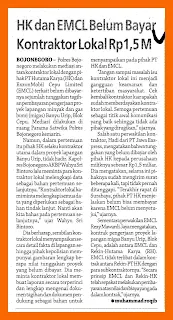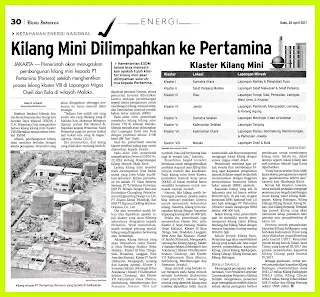The government will commission the construction of a mini refinery to PT Pertamina after stopping the VIII cluster auction process at the Oil and Gas Field of Osil and Bula in the Maluku region. Director General of Oil and Gas of the Ministry of Energy and Mineral Resources (ESDM) I G.N. Wiratmaja Puja said that the auction of the Cluster VIII mini refinery was stopped in accordance with the direction of the Minister of Energy and Mineral Resources. As a result, the construction of a mini refinery will run with an assignment scheme. Pertamina to be assigned so that the company must find a strategic partner.
Wiratmaja said, from the auction that has been obtained by the applicant. However, the investor search process is stopped because there are considerations such as experience factors to build refineries, find partners, and ease of selling fuel oil products (BBM).
At the end of 2016, the government opened the auction of Cluster VIII mini refinery in Maluku region. Crude oil will be imported from Oceil and Bula Field with production of around 3,500 barrels per day (bpd).
At that time, the government considered the cluster the most ready to be offered to the private sector. At the end of 2016, the government issued ESDM Government Regulation no. 22/2016 on Small-Scale Oil Refinery Development.
The mini refinery auction has received five business entities that pass the document qualification stage. The five companies are PT Alam Bersemi Sentosa, PT Tri Wahana Universal, KSO PT Remaja Bangun Kencana Contractor-Changling Petrochemical Engineering Design Co. Ltd., PT Cross Technology Alliance, and KSO PT Hamloni Drilling Services Oceanus Co. Ltd.
Wiratmaja said it is still unclear whether seven clusters will be auctioned entirely to Pertamina. Wiratmaja said, there is still a chance that the number of refineries assigned is reduced or increased.
The other refineries to be offered are Klaster ll Strait of Malacca Strait, Klaster III Riau (Tonga, Siak, Pendalian, Langgak, West Ama and Kisaran), Cluster IV Jambi (Palmerah, Mengoepeh, Bemang and Karang Agung) Klaster V South Sumatera (Merangin II and Ariodamar), Klaster VI South Kalimantan (Tanjung), and VII Cluster of North Kalimantan (Bunyu, Sembakung, Memburungan and Pamusian Juwala).
The issuance of the beleid aims to optimize the production of ready-to-sell or lifting of crude oil and condensate. In a cluster-type mini refinery, a contracting contractor (KKKS) at a nearby location must have a commitment to supply crude oil.
However, if refineries are still short of supply, business actors may seek other supplies to meet refinery needs. The reason, the mini refinery is a refinery with an installed capacity of less than 20,000 bpd. In addition, the government also offers other clusters, namely Klaster II Straits of Malacca Straits, Riau Ill Clusters (Tonga, Siak, Pendalian, Langgak, West Area and Kisaran), Cluster IV Jambi (Palmerah, Mengoepeh, Lemang and Karang Agung ), South V Sumatra Cluster (Merangin II and Ariodamar), Klaster VI South Kalimantan (Tanjung), and VII Cluster of North Kalimantan (Bunyu, Sembakung, Memburungan and Pamusian Juwata).
The prevailing oil price still refers to the Indonesian crude price (ICP). However, the price of oil obtained by the mini refinery is certainly cheaper because there is no transponency cost considering the location of the refinery with oil and gas wells is relatively close.
The government requested that the private sector participate in building refineries in order to increase domestic oil processing capacity adjusting to the high growth of national fuel consumption (BBM).
The capacity of existing refineries in Indonesia is currently only about 800,000 bpd. On the other hand, the national fuel consumption level is now 1.6 million bpd so that PT Pertamina still imports about 800,000 bpd of fuel. In addition to the mini refinery, the government currently has a refinery development project, namely Bontang and Tuban Refinery with a capacity of 300,000 bph.
In addition to the new refinery project, Pertamina will also revitalize its existing refineries. There are four refinery capacity addition projects, namely Balikpapan Refinery, Cilacap Refinery, Dumai Refinery and Balongan Refinery.
REVIEWED FIRST
Responding to the assignment from the government, Pertamina Corporate Communication Vice President Adiatma Sardjito said the company will first study the scheme related schemes and funding to build a mini refinery. In addition, other details such as the location of the refinery and the origin of the oil supply should also be considered.
All these things, should be a concern considering the company is currently building six refineries namely Balikpapan Refinery, Balongan Refinery, Cilacap Refinery, Dumai Refinery, Tuban Refinery, and Bontang Refinery. There are three refinery projects that will enter the groundbreaking grounding stage this year.
First, the capacity building project of Balikpapan refinery located in East Kalimantan which will be groundbreaking in the first quarter of 2017. Then the new refinery project in Tuban, East Java in the third quarter / 2017 and project capacity addition of Cilacap refinery in quarter IV / 2017.
As an illustration, the Balongan Refinery project will cost US $ 1.27 billion, Balikpapan Plantation worth US $ 5.3 billion, Cilacap Refinery of US $ 4.5 billion, Tuban Refinery of US $ 13 billion and Bontang Refinery worth US $ 8 billion.
IN INDONESIAN
Kilang Mini Dilimpahkan ke Pertamina
Pemerintah akan menugaskan pembangunan kilang mini kepada PT Pertamina setelah menghentikan proses lelang klaster VIII di Lapangan Migas Osil dan Bula di wilayah Maluku. Direktur Jenderal Minyak dan Gas Bumi Kementerian Energi dan Sumber Daya Mineral (ESDM) I G.N. Wiratmaja Puja mengatakan bahwa lelang kilang mini Klaster VIII dihentikan sesuai arahan Menteri ESDM. Alhasil, pembangunan kilang mini nantinya berjalan dengan skema penugasan. Pertamina yang akan ditugaskan sehingga perseroan itu harus mencari mitra strategis.
Wiratmaja menuturkan, dari lelang yang dilakukan memang telah didapatkan peminat. Namun, proses pencarian investor dihentikan karena terdapat pertimbangan seperti faktor pengalaman untuk membangun kilang, mencari mitra, dan kemudahan menjual produk bahan bakar minyak (BBM).
Pada akhir 2016, pemerintah membuka lelang kilang mini Klaster VIII di wilayah Maluku. Minyak mentah akan didatangkan dari Lapangan Oseil dan Bula dengan produksi sekitar 3.500 barel per hari (bph).
Saat itu, pemerintah menilai klaster tersebut paling siap untuk ditawarkan kepada swasta. Pada akhir 2016, pemerintah mengeluarkan Peraturan Pemerintah ESDM No. 22/2016 tentang Pengembangan Kilang Minyak Skala Kecil.
Lelang kilang mini tersebut telah mendapatkan lima badan usaha yang lolos tahap kualifikasi dokumen. Kelima perusahaan itu adalah PT Alam Bersemi Sentosa, PT Tri Wahana Universal, KSO PT Remaja Bangun Kencana Kontraktor-Changling Petrochemical Engineering Design Co. Ltd, PT Aliansi Lintas Teknologi, dan KSO PT Hamloni Drilling Services Oceanus Co. Ltd.
Wiratmaja menyebut masih belum bisa dipastikan apakah tujuh klaster vang akan dilelang seluruhnya ditugaskan kepada Pertamina. Wiratmaja menuturkan, masih terdapat peluang jumlah kilang yang ditugaskan berkurang atau bertambah.
Adapun, kilang lainnya yang akan ditawarkan yakni Klaster ll Selat Panjang Malaka (Selat Malaka), Klaster III Riau (Tonga, Siak, Pendalian, Langgak, West Ama dan Kisaran), Klaster IV Jambi (Palmerah, Mengoepeh, bemang dan Karang Agung), Klaster V Sumatera Selatan (Merangin II dan Ariodamar), Klaster VI Kalimantan Selatan (Tanjung), dan Klaster VII Kalimantan Utara (Bunyu, Sembakung, Memburungan dan Pamusian Juwala).
Penerbitan beleid tersebut bertujuan untuk mengoptimalkan produksi siap jual atau lifting dari minyak mentah dan kondensat. Pada kilang mini jenis klaster, kontraktor kontrak kerja sama (KKKS) di lokasi terdekat harus memiliki komitmen untuk memasok minyak mentah.
Namun, bila kilang masih kekurangan pasokan, pelaku usaha bisa mencari pasokan lainnya untuk memenuhi kebutuhan kilang. Pasalnya, kilang mini merupakan kilang dengan kapasitas terpasang kurang dari 20.000 bph. Selain itu, pemerintah juga menawarkan klaster lain, yaitu Klaster II Selat Panjang Malaka (Selat Malaka), Klaster Ill Riau (Tonga, Siak, Pendalian, Langgak, West Area dan Kisaran), Klaster IV Jambi (Palmerah, Mengoepeh, Lemang dan Karang Agung), Klaster V Sumatra Selatan (Merangin II dan Ariodamar), Klaster VI Kalimantan Selatan (Tanjung], dan Klaster VII Kalimantan Utara (Bunyu, Sembakung, Memburungan dan Pamusian Juwata).
Harga minyak yang berlaku tetap mengacu pada harga minyak mentah Indonesia (Indonesian crude price/ICP). Namun, harga minyak yang diperoleh kilang mini tersebut dipastikan lebih murah karena tidak ada biaya transponasi mengingat lokasi kilang dengan sumur migas relatif dekat.
Pemerintah meminta agar pihak swasta ikut membangun kilang agar kapasitas pengolahan minyak di dalam negeri bertambah menyesuaikan dengan tingginya pertumbuhan konsumsi bahan bakar minyak (BBM) nasional.
Kapasitas kilang yang ada di Indonesia saat ini hanya sekitar 800.000 bph. Di sisi lain, tingkat konsumsi BBM nasional kini 1,6 juta bph sehingga PT Pertamina masih mengimpor BBM sekitar 800.000 bph. Selain kilang mini, pemerintah saat ini memiliki proyek pembangunan kilang yakni Kilang Bontang dan Kilang Tuban dengan rencana kapasitas masing-masing 300.000 bph.
Selain proyek kilang baru, Pertamina juga akan merevitalisasi kilang yang sudah ada. Ada empat proyek penambahan kapasitas kilang, yakni Kilang Balikpapan, Kilang Cilacap, Kilang Dumai dan Kilang Balongan.
DITINJAU DAHULU
Menanggapi penugasan dari pemerintah, Vice President Corporate Communication Pertamina Adiatma Sardjito mengatakan, perseroan akan mempelajari terlebih dahulu terkait skema penugasan berikut pendanaan untuk membangun kilang mini. Selain itu, detail lainnya seperti lokasi kilang dan asal pasokan minyak juga harus diperhatikan.
Semua hal tersebut, harus menjadi perhatian mengingat perseroan pun sedang membangun enam kilang yakni Kilang Balikpapan, Kilang Balongan, Kilang Cilacap, Kilang Dumai, Kilang Tuban, dan Kilang Bontang. Terdapat tiga proyek kilang yang akan memasuki tahap peletakan batu pertama atau groundbreaking di tahun ini.
Pertama, proyek penambahan kapasitas Kilang Balikpapan yang berlokasi Kalimantan Timur yang akan dilakukan groundbreaking pada kuartal I/2017. Kemudian proyek kilang baru di Tuban, Jawa Timur pada kuartal III/2017 dan proyek penambahan kapasitas Kilang Cilacap pada kuartal IV/2017.
Sebagai gambaran, untuk proyek penambahan kapasitas Kilang Balongan membutuhkan dana US$1,27 miliar, Kilang Balikpapan US$5,3 miliar, Kilang Cilacap US$4,5 miliar, Kilang Tuban sekitar US$13 miliar dan Kilang Bontang sekitar US$8 miliar.
Bisnis Indonesia, Page-30, Wednesday, April, 26, 2017









